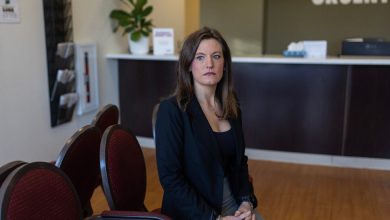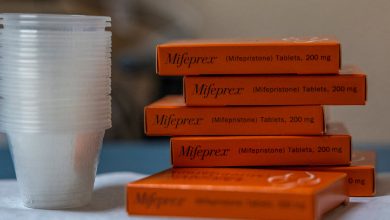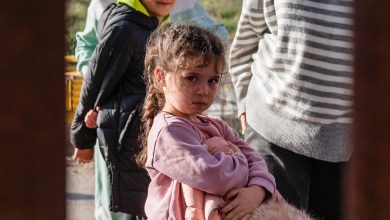They Were Sure Their High School Was Making Them Sick. Experts Disagreed.

Al Lupiano, his wife and his sister all had brain tumors.
It started in 1999 when Mr. Lupiano, then 27, was diagnosed with a noncancerous one. Twenty-two years later, in 2021, doctors discovered that his wife, Michele, had a tumor, a benign acoustic neuroma on the left side of her brain. On the same day, his sister, Angela, learned she had a fast-growing malignant tumor, also on the left side of her brain.
All three had attended Colonia High School in Woodbridge, in central New Jersey, and soon enough, Mr. Lupiano began asking on Facebook and on a local news site if any other graduates had similar diagnoses. After Angela died in February, at the age of 44, Mr. Lupiano says, he started his outreach in earnest, fueled by a promise to his late sister to seek an explanation. “Something is wrong here,” he said.
On April 10, Mr. Lupiano’s list of former students and staff members with primary brain tumors hit 100 names.
Jason Wisinski, who lost his wife and sister-in-law, both Colonia High alumnae, to primary malignant brain tumors at the age of 38, became one of many convinced that a cluster — a hyperlocal blight of cancer — could explain why so many young residents were succumbing to tumors. “There’s something there, in Colonia,” Mr. Wisinski said. “I’m 99.99 percent convinced.”
But in the field of public health, cancer clusters are defined by statistics, not gut instincts. According to the Centers for Disease Control and Prevention, a true cancer cluster must represent a greater-than-expected number of cancer cases — of the same type of cancer, or those proven to share the same cause, within a specific population over a set time. This is a high bar to clear.
Of the estimated 1,000 suspected cancer clusters reported to health departments each year, only a small fraction will prove themselves to be statistically significant cancer surges. And experts have been able to identify a clear cause in only a tiny percentage of those. (In one scientific review of 428 cancer cluster investigations over 21 years, for example, just one in eight cases was a confirmed increase in cancer and only one investigation revealed a definitive source.)
Despite these odds, cancer cluster designations are considered crucial for both health officials interested in protecting public safety, and communities who fear they’ve been exposed to cancer-causing agents. The designation is the first, prerequisite step on the path toward a full-throated response, from investigation to cleanup and remediation and, potentially, legal recourse.
In 2016, Congress passed Trevor’s Law, named after a survivor of childhood brain cancer linked to a suspected cluster in Idaho deemed too small to study. “What happened in my community continually repeats itself throughout this entire country, year in and year out,” that survivor, Trevor Schaefer, told lawmakers in 2011. “Parents are trying to get authorities to investigate these clusters and to discern what caused the disease patterns. Scientists and health activists say the government’s current response to disease clusters ranges from piecemeal to nonexistent.”
Among other things, the law calls for periodic updates to federal cluster investigation guidelines — work that the C.D.C., compelled by the legislation, began in 2018. In its first update to the guidelines since 2013 (which are expected to be finalized this year) the agency acknowledges that barriers to discovering and declaring true clusters remain. However, the agency accepts a greater responsibility for helping communities cope with this uncertainty and the lack of resolution that often characterizes these investigations. “We recognized that communication guidance was an area that warranted attention,” said Patrick Breysse, director of the C.D.C.’s National Center for Environmental Health and the Agency for Toxic Substances and Disease Registry, in an email statement.
The updates also move to de-emphasize statistical significance as the main criterion for investigating suspected cancer clusters in order to make more room for other criteria, such as mortality and electronic health record data, neighborhood patterns of cancer and even community-created lists of individuals with cancer diagnoses.
What happened in Woodbridge illustrates the need for these changes, especially those aimed at bolstering the relationship between a concerned community and the public health experts facing the difficult task of investigating a suspected cluster.
Even before Mr. Lupiano’s list had reached 100 people, it had drawn the attention of local and national news media and had catalyzed public officials to act. “There could be a real problem here, and our residents deserve to know if there are any dangers,” Woodbridge’s mayor, John McCormac, said in April.
The Woodbridge town council spent $221,000 to deploy 83 radon testing devices and conduct radiological testing at the school building and encircling 28-acre campus. Officials also reviewed local data on naturally occurring radioactive deposits and followed up on reports of a radioactive rock discovered in a science classroom in 1997.
The state’s environmental agency confirmed that the water company — which does not use water from ground wells known to be pollution-prone — serving the area had not had any violations for radiological contaminants since at least 2004. The state’s health department calculated it would be statistically ordinary for about 120 former students and staff members to have developed brain tumors in the decades since the school was built in 1967.
On May 26, Mayor McCormac and state environmental and public health officials held a news conference in the high school’s gymnasium to share their final determination: There was no indication of any potential radiological hazards that would warrant further inquiry. By the time students let out for the summer, the case was closed.
“There never was a cancer cluster,” Mr. McCormac said in June. “We have to accept the results.”
But many in the community do not accept them. The investigation wasn’t thorough enough, residents argue, and didn’t involve water testing or analysis of the soil beyond radiological tests. “What we were not prepared for was for the state to say, ‘We’re satisfied,’ after doing one simple test,” Mr. Lupiano said.
Rich Strack, who taught English and philosophy at Colonia for about 30 years, likened the situation to a “dark cloud” hanging over the school. “The study doesn’t close anything. It opens up more questions, more doubts, more anxieties, more concerns,” he said. “It doesn’t just go away because the test says all clear.”
In Woodbridge and elsewhere, unresolved concerns — regardless of whether more can be done, scientifically — can seed deep distrust and suspicion in suspected cluster communities. That’s why scientists and responders bear a great responsibility when it comes to helping citizens navigate uncertainty around a disease like cancer, which on its own can feel random and inexplicable.
For public health officials, resolving this tension is the macro version of bedside manner: How do you reassure a frightened patient that nothing’s wrong? And when do you need to check your own biases, and take patients’ concerns more seriously?
About one in three people develop cancer over a lifetime and one in five will die from it. While the death rate from cancer is dropping thanks to improving treatments and early detection, the total number of cancer cases in the United States is expected to rise by 50 percent compared to 2015 cases due in large part to aging populations.
When faced with terminal disease, people often look for an overarching explanation as a way to cope with an unbearable reality. They may seek answers where there are not any — or where they are impossible to dredge out.
“There’s something special about cancer,” said Richard Clapp, a cancer epidemiologist and a professor emeritus at Boston University. “It confers such chaos into the people who are affected by it.”
Humans are awash in potential cancer-causing agents, and it is practically impossible to determine the cause of a given case. Cancer does not awaken all at once. Instead, an amalgam of carcinogens, genetic predispositions, social factors, lifestyle choices, natural aging and the random chance of spontaneous mutation sets it off, bit by bit, year by year, even decade by decade.
“By the time you see a tumor in a mammogram, it may be that that tumor has been growing for six years,” said Rachel Morello-Frosch, a professor of public health at the University of California, Berkeley. “It’s very hard to pinpoint what it is that initiated that process.”
Of the 120 or so known carcinogens, some are inescapable, like sunshine, engine exhaust, air pollution or the asbestos still embedded in millions of older buildings. Others we choose to consume: alcohol, tobacco, processed meat, tanning beds. Some workers, such as miners and firefighters, are exposed to known carcinogens during their careers. The natural world can also pose a threat via volcanic ash or toxin-spewing fungi. There are hundreds more probable carcinogens of varying ubiquity under study, from pesticides to parasites, night shifts and indoor fires.
But not all carcinogens cause cancer every time. Some depend on the type of exposure, others unleash carcinogenesis only in people with the right genetic predisposition. Dose, too, is a major factor.
This helps explain why cluster investigations so often fail to arrive at a satisfying conclusion. Since cancer can take such a long time to manifest, evidence of what caused it has ample time to disappear. People move in and out of town. Pollution gets cleaned up or dissipates into the air. People struggle to recall their past daily lives — which seat they sat in during high school chemistry, or where their drinking water came from five years ago. “You’re looking for footprints in the sand long after the tide has come and gone,” said Dr. Clapp.
A nationwide constellation of state cancer databases was put in place in 1992, but these cancer registries often fail to account for changes in residency. The size of neighborhood clusters are often too small to yield statistically significant results. Beyond the adoption of genomic testing, which might identify a telltale genetic signature among patients with the same kind of cancer, no technological fix yet promises to address these problems.
In the case of Colonia High School, many of these valid limitations apply. The New Jersey cancer registry offers little help, since not everyone who went to or worked at Colonia still lives in Woodbridge, and not everyone in Woodbridge went to Colonia. When the state health department calculated the number of brain and other nervous system tumors that would expected among the cohort of students and staff from 1968 to 2021, it concluded it could be up to 120 individuals — just slightly under Mr. Lupiano’s count of about 125 (though he believes his tally is an undercount). At least one epidemiologist I spoke to for this article told me that, just glancing at the numbers, he wasn’t surprised that public officials have determined Colonia was not a true cluster.
Even so, these constraints do not relieve public health departments from their duty to do all they can to address their constituents’ concerns — even if they can’t deliver definitive answers and even if they are under strain themselves. “The perception of a cluster in a community may be as important as, or more important than, an actual cluster,” the C.D.C. observed in 1990.
In addition to leaning less heavily on statistical significance, the federal agency’s new updates also call for an evolution in the interpersonal aspects of a cluster investigation. “The draft guidelines promote listening skills and empathy on the part of state and local health department representatives, the sharing of information upon which decisions are made, and developing communication plans in advance of concerns being raised to build trust and credibility,” said Dr. Breysse. That could look like presenting the public with clearer timelines of an investigation’s course of action, creating portals to gather community feedback and encouraging “two-way communications from the start.”
After all, there has been a long history of patients serving as a critical warning system for epidemiology, with concerned residents having alerted public health officials to mercury poisoning diseases, birth defects caused by rubella, and toxic drinking water contaminants. “Very often the first time public health officials learn about a potential community health threat,” said Dr. Morello-Frosch, “is through community members themselves.”
At the Colonia High School news conference in May, reporters pressed a panel of state experts on the decision not to test water and soil, even if just to reassure concerned community members that there was nothing there.
That kind of follow-up could potentially have the opposite effect, said Shawn LaTourette, New Jersey’s commissioner of environmental protection, and send “the wrong message” that the suspicions deserved any more resources than what had already been invested.
One month later, Mayor McCormac echoed this sentiment to me: “It’s frustrating that people who hoped that there was no radiation on the site now are upset that there’s not,” he said. “They asked us to do this and we did it. We did exactly what they wanted.”
But some still want more. Edyta Komorek, an environmental scientist and mother of a Colonia High School rising junior and freshman, was not pacified by the results. “If I trusted those numbers, I would be relieved and I would be happy,” she said.
At an educational board meeting in June, Mrs. Komorek laid out the possible leads she and others would like to see explored, like whether the school’s 1960s-era building materials contain mercury or formaldehyde. Schools in North Brunswick and Trenton, as well as in Greenwich, Conn., and Northport, N.Y., were discovered to have been constructed on or near contaminated soils. “It is not unfathomable that it may have happened in Colonia,” Mrs. Komorek told the board.
Several people raised questions to me about the state health department’s analysis. Why would they include classes as recent as 2021 when we know many cancers take decades or longer to develop? Why hasn’t anyone confirmed Mr. Lupiano’s list, in order to have an official tally to compare to the official estimate?
It’s unclear whether any of those questions will ever be answered, and if they are, how residents would receive the responses. For a community desperate for sense-making answers, it may be a bitter truth: There is more cancer around us than we can comprehend, and yet not enough to make scientific sense of.
“Even if evidence is black and white, it’s hard to convince people of something they aren’t prepared to believe,” said Robert Laumbach, a professor of public health at Rutgers University who is leading a federal study of “forever chemicals” in Gloucester County, in southwestern New Jersey. “They can find reasons to doubt. Some people will not be convinced.”
But Mr. Lupiano said he ultimately hopes — one way or another — to be assured that all is as it should be. “Prove to us there’s nothing,” he said.
Marion Renault is a health and science journalist.
The Times is committed to publishing a diversity of letters to the editor. We’d like to hear what you think about this or any of our articles. Here are some tips. And here’s our email: [email protected].
Follow The New York Times Opinion section on Facebook, Twitter (@NYTopinion) and Instagram.




